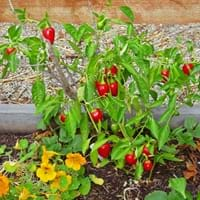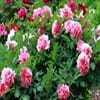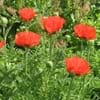Life Span
Perennial
Annual
Type
Flowering Plants, Herbaceous Perennial
Vegetable
Origin
Asia
Mexico, Central America, South America
Types
Bowl of Beauty, Laura Dessert
Not Available
Habitat
Dappled Shade, Woodland Garden
Open areas
USDA Hardiness Zone
4-8
Not Available
Sunset Zone
A3, 1a, 1b, 2a, 2b, 3a, 3b, 4, 5, 6, 7, 8, 9, 10, 11, 12, 13, 14, 15, 16, 17, 18, 19, 20, 22
A1, A2, A3, H1, H2, 1a, 1b, 2a, 2b, 3a, 3b, 4, 5, 6, 7, 8, 9, 10, 11, 12, 13, 14, 15, 16, 17, 18, 19, 20, 21, 22, 23, 24
Habit
Clump-Forming
Upright/Erect
Flower Color
White, Light Pink
White
Flower Color Modifier
Bicolor
Bicolor
Fruit Color
Not Available
Red, Green
Leaf Color in Spring
Red, Dark Green, Bronze
Dark Green
Leaf Color in Summer
Green, Dark Green
Green
Leaf Color in Fall
Green, Dark Green, Bronze
Green, Black
Leaf Color in Winter
Not Available
Dark Green
Leaf Shape
Lance shaped
Ovate
Plant Season
Spring, Summer
Spring, Summer, Fall
Sunlight
Full Sun, Partial Sun
Full Sun
Type of Soil
Clay, Loam, Sand
Loam, Sand
The pH of Soil
Acidic, Neutral, Alkaline
Neutral
Soil Drainage
Well drained
Well drained
Bloom Time
Late Spring, Early Summer
Spring, Summer, Indeterminate
Tolerances
Not Available
Drought
Where to Plant?
Ground
Container, Ground
How to Plant?
Root Division, Seedlings
Seedlings, Transplanting
Plant Maintenance
Medium
Medium
Watering Requirements
Allow soil to be completely dry in between waterings, Water Deeply
Do Not over Water
In Summer
Lots of watering
Lots of watering
In Spring
Moderate
Moderate
In Winter
Average Water
Average Water
Soil pH
Acidic, Neutral, Alkaline
Neutral
Soil Type
Clay, Loam, Sand
Loam, Sand
Soil Drainage Capacity
Well drained
Well drained
Sun Exposure
Full Sun, Partial Sun
Full Sun
Pruning
Remove damaged leaves, Remove dead branches, Remove dead leaves
Remove damaged leaves, Remove dead branches, Remove dead leaves
Fertilizers
5-10-10 fertilizer
All-Purpose Liquid Fertilizer
Pests and Diseases
Leaf Blotch, Ringspot virus, Stem rot, Tip blight, Verticillium Wilt
Not Available
Plant Tolerance
Drought
Drought
Flower Petal Number
Double
Single
Foliage Texture
Coarse
Medium
Foliage Sheen
Glossy
Glossy
Attracts
Ants, Butterflies, Not Available
Not Available
Allergy
no allergic reactions
Hives, Rash
Aesthetic Uses
Cut Flowers, Showy Purposes
Showy Purposes
Beauty Benefits
Not Available
Not Available
Environmental Uses
Air purification
Air purification
Medicinal Uses
Alterative, Analgesic, Anodyne, anti inflammatory, Antibacterial, Antiseptic, Hypotensive, Tonic
cholesterol-lowering, Low calories, Vitamin C
Part of Plant Used
Root, Seeds, Stem
Fruits
Other Uses
Eaten in a broth, Powdered and mixed with tea
Used As Food
Used As Indoor Plant
Yes
No
Used As Outdoor Plant
Yes
Yes
Garden Design
Cutflower, Feature Plant, Foundation, Mixed Border
Bedding Plant, Container, Edible, Herb / Vegetable, Mixed Border, Tropical
Botanical Name
PAEONIA lactiflora 'Shirley Temple'
CAPSICUM annuum 'Cherry Bomb'
Common Name
Double Pink Peony, Garden Peony
Cherry Bomb Pepper, Cherry Pepper
In Hindi
Double Pink Peony
Cherry Bomb Pepper
In German
Doppelte rosa Pfingstrosen
Cherry Bomb Pfeffer
In French
Double Rose pivoine
Cherry Bomb Pepper
In Spanish
Doble Pink Peony
Bomba de cereza Pimienta
In Greek
Διπλό Ροζ Παιωνία
Cherry Bomb Πιπέρι
In Portuguese
Duplo Pink Peony
Cherry Bomb Pimenta
In Polish
Podwójne Pink Peony
Cherry Bomb Pepper
In Latin
Geminus Pink AGLAOPHOTIS
Cherry Bomb Pepper
Phylum
Magnoliophyta
Anthophyta
Class
Magnoliopsida
Eudicotyledones
Order
Dilleniales
Solanales
Family
Paeoniaceae
Solanaceae
Clade
Angiosperms, Core eudicots, Eudicots
Angiosperms
Tribe
Not Available
Not Available
Subfamily
Not Available
Not Available
Number of Species
Not Available
Not Available
Importance of Double Pink Peony and Cherry Bomb Pepper
Want to have the most appropriate plant for your garden? You might want to know the importance of Double Pink Peony and Cherry Bomb Pepper. Basically, these two plants vary in many aspects. Compare Double Pink Peony and Cherry Bomb Pepper as they differ in many characteristics such as their life, care, benefits, facts, etc. Every gardener must at least have the slightest clue about the plants he wants to plant in his garden. Compare their benefits, which differ in many ways like facts and uses. The medicinal use of Double Pink Peony is Alterative, Analgesic, Anodyne, anti inflammatory, Antibacterial, Antiseptic, Hypotensive and Tonic whereas of Cherry Bomb Pepper is cholesterol-lowering, Low calories and Vitamin C. Double Pink Peony has beauty benefits as follows: Not Available while Cherry Bomb Pepper has beauty benefits as follows: Not Available.
Compare Facts of Double Pink Peony vs Cherry Bomb Pepper
How to choose the best garden plant for your garden depending upon its facts? Here garden plant comparison will help you to solve this query. Compare the facts of Double Pink Peony vs Cherry Bomb Pepper and know which one to choose. As garden plants have benefits and other uses, allergy is also a major drawback of plants for some people. Allergic reactions of Double Pink Peony are no allergic reactions whereas of Cherry Bomb Pepper have Hives and Rash respectively. Having a fruit bearing plant in your garden can be a plus point of your garden. Double Pink Peony has no showy fruits and Cherry Bomb Pepper has showy fruits. Also Double Pink Peony is not flowering and Cherry Bomb Pepper is flowering. You can compare Double Pink Peony and Cherry Bomb Pepper facts and facts of other plants too.





